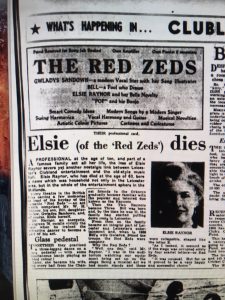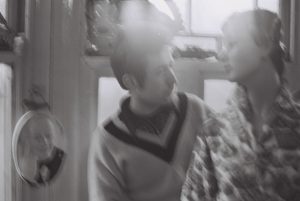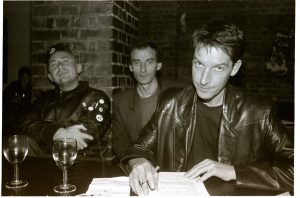Stephane Raynor obituary
I first met Stephane Raynor through my brother Jack. This would have been about 1964. I was 13 years old. Jack was 16 and Steph 19. My parents had taken on a village pub in Tugby, 12 miles from Leicester, two buses a day. Steph’s green Morris Minor pulled into the pub yard and Jack and Steph, who shared a common interest in music and clothes, drove away towards the Isle of Wight. After a couple of days my Dad called the police not knowing where Jack had gone. For some obscure reason I had made a note of the registration of the car. It seemed like a good idea at the time and the police agreed. Cars always figured large in Steph’s life. He was rarely seen walking and as far as I know never used public transport of any kind. The car was his armour and enabled him to maintain independence and relative isolation. I interviewed him in 2018 for my book Perfect Binding and he said :
“The cars I always liked were the Riley Pathfinder or the Mark 2 Jaguar which were in the TV shows, the cops all had cars like the Jaguar Mark 2 and then there were the sports cars like the MG TF which I really wanted, which were £380 and I could only raise £250. I wanted a cream MG TF with spoked wheels and a luggage rack on the back with a leather suitcase on it… …it was a cool dude’s car, even actors in Hollywood had one. The Ford Classic that I had was a cool car”.
There is a film called C’Etait Un Rendezvous, made in 1976 by Claude Lelouch that Steph liked. Filmed in one continuous take, the camera attached to a car driving through Paris at high speed. The car goes through red lights, scattering pigeons, avoiding rubbish vans and buses and ends at Montmartre. The last few seconds show the object of the drive, the reason for driving at such high speed, a woman ascending steps to meet the driver who we now see for the first time walking towards her. Steph said to me “well yeah, that bit is shit, that guy with his flared trousers…” for Steph, the drive was everything, the destination didn’t count.
https://www.youtube.com/watch?v=b9oO0mAESxAj
My Dad disliked Steph (and most of Jack’s friends in fact). He was everything that parents wanted their own kids to avoid. He was defiant, he came from Sparkenhoe Street; a terraced working class area of Leicester, now demolished. He didn’t shake hands or call anyone ‘sir’ in fact he hardly spoke at all, sometimes interpreted as shyness, he had ‘attitude’, … my Dad didn’t want him in the pub. David Parkinson’s Dad didn’t want him to park his car on the street where he lived. He wanted him out of his field of vision.
Steph worked briefly at Brevitt’s, a shoe factory in Leicester where his Dad was a van driver. Steph wanted to escape from the factory, and Leicester, and eventually succeeded.
Stephane was an only child born July 22nd 1945. His parents were William Hardie Raynor Junior, and Gladys Violet Raynor (née Blake) and both were variety artists from performing families. Addresses included Shanklin on the Isle of Wight. They married in early 1942 but had already been living together for some years. In 1939 they were living with the Raynor family in Doncaster:
William Raynor and Elsie Raynor, William Raynor jnr. and Gladys Blake – amended in 1947 to Gladys Raynor, sometimes called Gladys Sandown. All four occupants’ professions are listed as “variety artiste”.
Steph’s mother, had at least one sister and two brothers. The Blake family were based on the Isle of Wight. Gladys Blake’s ‘suspected’ grandfather was Tony Blake, listed in 1939 as a “retired comedian”.
The 4 Raynors; that is Steph’s grandparents and parents, formed a troupe called The Four Red Zeds, a complete entertainment unit, billed as: Gladys Sandown; a modern vocal star with her song illustrator, Bill; a fool who draws; Elsie Raynor and her Bells Novelty (?) and “Pop” and his banjo, so quite an eccentric combo. In the 1930s each of the Zeds had names – Zoe, Zena, Zip and Zero. They originally practised a three legged dance on a glass pedestal with banjo backing and were apparently a household name in the Midlands. They are listed in the Radio Times as appearing on the radio in March 1946 headlined by Dorothy Squires and on BBC television in August 1946 with Mantovani. In 1947 Steph’s parents are listed as embarking at Hong Kong on the Alcantra sailing from Japan to the UK along with a whole troupe of musicians, dancers, band leader and artists.

Leicester Evening Mail, September 1958.
A colourful and fertile background then, and the story is that Steph was named after Stephane Grappelli the acclaimed jazz violinist, Steph’s Dad having a keen interest in jazz and Steph himself had a lifelong interest in music, played guitar, a brief spell in the Ten Foot High Things: Dave Parkinson on drums, Steph on guitar, one other, and my brother Jack was supposed to be vocalist though I’ve never heard him sing a note. At least they looked good when they appeared for one night at The Pit, a basement club under the Bond Street café in Leicester. An abiding rumour, promoted by Steph, was that he once auditioned for Soft Machine but there might have been a long queue. He was once briefly attached to a Leicester band called Aries. One memorable episode was when the leading member of Aries was depending on Steph to play a gig. Steph’s contemptuous response was “you might be gigging with Walrus but I’ll be at Tugby with a pint of beer and a cheese cob”.
The pub at Tugby was a strange little theatre. Deep in the Leicestershire countryside, it provided an oasis of sorts, but deteriorated over time, brought down by alcohol and mismanagement, but there was a period when Steph enjoyed the bucolic atmosphere, prepared to endure my Dad’s glare and play Scrabble, sometimes through the afternoon. He played slowly, determined not to make a wrong move. He once turned up at the pub with Sheffield Dave Towndrow, the two of them were briefly working at a rubbish recycling depot somewhere in the county. The choice of work was in itself a sort of defiant statement, a finger up to respectable society. The car pulled into the pub yard with Steph and Dave, covered in grime, long hair and beards, the car displaying trophies such as a headless teddy bear salvaged from the depot.
He deliberated for many weeks about getting his hair cut. It was 1972 and his old friend, photographer David Parkinson, based in London, had had his hair cut. Long hair by then had become passé. It was at this point that he turned from hippy drop-out to dealer, buying and selling clothes and tin toys.
I joined him on some of the foraging trips and one day after a few random enquiries we found a warehouse in a suburb of Wellingborough or maybe it was Kettering. It was a sort of elephants’ graveyard of bankrupt stock that nobody wanted and there were racks of extraordinary garments, early 1950s possibly late 1940s jackets, shades of lovat green with window pane checks and padded shoulders with strange details and lapels, some of which were sold to McLaren and Westwood’s Let it Rock in its retro 1950s hey day… back at the pub in Tugby we traded tin toys, the ultimate toy being a priceless robot that started as a cube and after whirring and grinding, grew limbs, stood up, and walked.

Steph circa 1972 in Leicester. Photograph by William English.
Jack was going through a traumatic phase and wanted none of it, instead collecting Mrs Beeton’s cook books, an antique ventriloquist’s doll and yellow clown shoes, and took an unsuitable job in another pub somewhere even deeper in the countryside. After a late night SOS, Steph and I drove through the night to collect him and bring him back to Tugby. You could liken it to Withnail and I but it wasn’t a movie, it was all quite surreal in a very English way.
In 1972 when I first went to the London film school, we drove through the night down the A1 in his Beetle convertible listening to Miles Davis’ Bitches Brew on French radio.
When my Messerschmitt ran out of petrol in the Hyde Park corner underpass, he came to my assistance with a can of petrol. When my brother’s girlfriend left him, Steph turned up to do what he called “the buddy thing”.
After my Leicester memoir; Perfect Binding was published in 2019 an old girlfriend of Steph’s sent me an email which expressed bitter, vitriolic sentiments which I won’t repeat here. I think he left a trail of fractured and bruised relationships.
The series of shops that Steph was involved with over the decades; Acme Attractions, BOY, PX, LaLa shop, Sick and finally Bad Phrmacy (sic) were all notable for not just being places where you bought something and left, they were often catalysts for something else, places where like minded people would encounter each other. In fact, I don’t think Steph was ever particularly interested in making money. Ever since the 1960s he was preoccupied with being ‘on the scene’, being at the right place at the right time.
Contrary to some of the grandiose claims in his memoir All About The Boy, I don’t remember Steph as a designer or an artist or a poet. In my mind he was none of these things and I think that’s what I liked about him, something indefinable, a rebel without a cause. Despite the mixed reviews I will miss knowing that he is out there somewhere, with the attitude, an attitude that in another era might have led to a career in Vaudeville.
During the last 18 months leading up to Steph’s death on June 28th 2021 Sandra and I frequented a coffee bar on Whitecross Street on the way to the bookshop where I work. One of the baristas, a young Italian with a ring in his nose, tattoos, and a variety of t shirts with heavy metal connotations would often serve us. One day I noticed him seated in the almost empty café sketching in a notebook. A few weeks later I gave him two books about contemporary drawing for which he was very grateful. The third week of July, he presented us with a drawing which combined geometric lines with an abstract fluid splurge of colour and talked briefly about ‘sacred geometry’. Over two years I had never known his name so now I asked him and introduced myself and Sandra. “My name is Stefano”, he said.
Finally, after 4 months to the day, Steph was cremated at The City of London Cemetery, Manor Park. His closest living relatives; his cousins, instructed the undertakers to not divulge information about the funeral and accordingly they declined to speak to me at all. Likewise Hackney Council who had instructed Floyd’s funeral directors to deal with Steph’s body and were also under orders to have Steph’s mortal remains dealt with secretly. The only way I could find out when and where the cremation would take place was by systematically phoning 3 separate cemeteries every week, assuming that the funeral would take place in the east end. Had it taken place elsewhere I would have been stymied, and I was close to giving up when I phoned again on Monday 25th October and finally heard that the ‘direct cremation’ was scheduled for 9am Thursday 28th October. It turns out that his death was recorded as June 28th so it was exactly 4 months later. Arriving early at Manor Park, Sandra and I found the South Chapel, prepared with a bouquet of white roses. We had been informed by a telephone receptionist that we would not be allowed to enter the chapel as it had not been ‘hired’ as such. A direct cremation usually precludes any ceremony or readings, music, mourners, hearse, pall bearers etc. and in the event, at 9am precisely, a van arrived marked as a ‘private ambulance’ and a coffin was rolled out on to a bier (trolley) and into the chapel. The driver and his assistant looked somewhat surprised to encounter any mourners. A very helpful and pleasant young woman employee of the crematorium invited us in to the chapel and we were allowed to lay the bouquet on top of the coffin which had a brass plaque on top engraved with Steph’s name and brief details of age and date of death. Contrary to our expectations, we were asked if we would like music playing for entry and exit so I chose Stephane Grappelli and Yehudi Menuhin playing Autumn Leaves for the intro and Badge by Cream as the outro which seemed appropriate with the lines: “Thinkin’ ’bout the times you drove in my car” and “before they bring the curtain down”. All to a deserted chapel designed to seat about 100. I was allowed to press the button which closed the curtain.
March 2022 I applied online for a copy of the death certificate: Cause of death; I (a) Hypertensive heart disease II Emphysema. Occupation: Clothing Company Director, Bad Denim 82 Lower Clapton Road, Hackney E5.

Stephane Raynor, John ‘Jelly’ Nixon and Jack English in The Dining Room, Borough Market, London circa 1987. Photograph by William English.